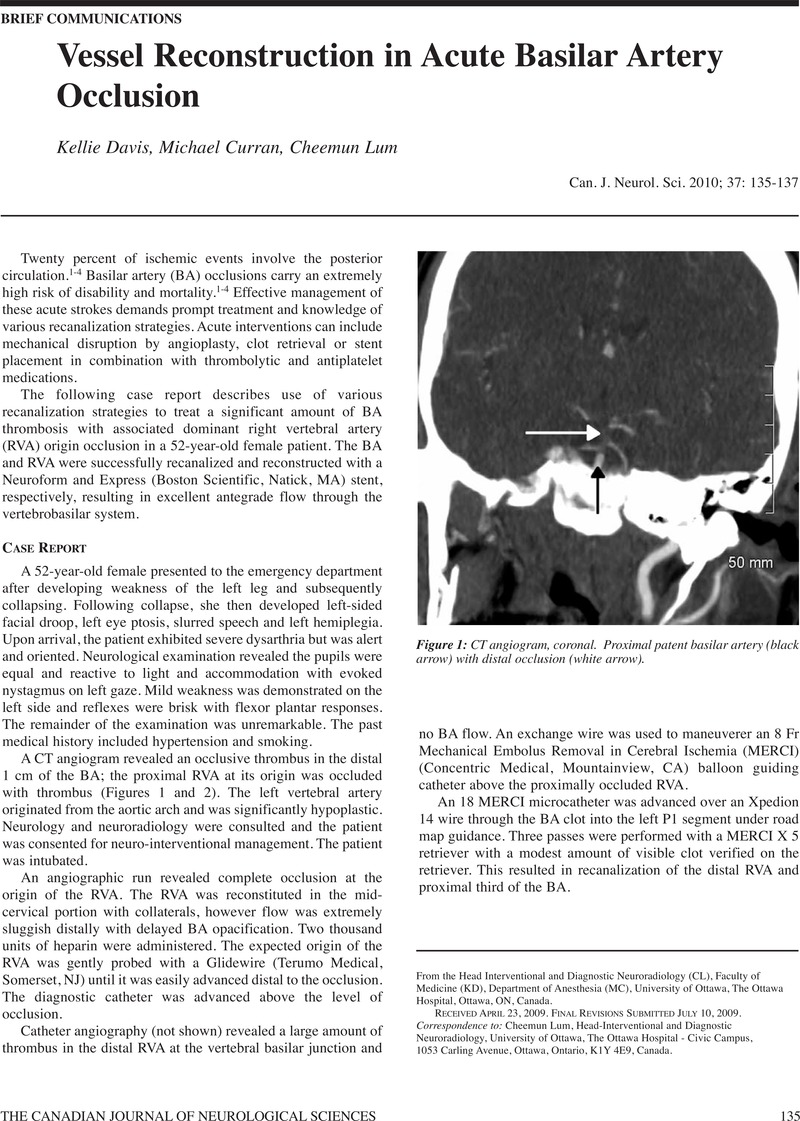No CrossRef data available.
Article contents
Vessel Reconstruction in Acute Basilar Artery Occlusion
Published online by Cambridge University Press: 02 December 2014
Abstract
An abstract is not available for this content so a preview has been provided. As you have access to this content, a full PDF is available via the ‘Save PDF’ action button.

- Type
- Brief Communications
- Information
- Copyright
- Copyright © The Canadian Journal of Neurological 2010
References
2.
Caplan, LR.
Posterior circulation disease: clinical findings, diagnosis, and management. Cambridge Mass: Blackwell Sciences; 1996.Google Scholar
3.
Voetsch, B, Dewitt, LD, Pessin, MS, Caplan, LR.
Basilar artery occlusive disease in the New England Medical Center posterior circulation registry. Arch Neurol.
2004;61:496–504.CrossRefGoogle ScholarPubMed
4.
Glass, TA, Hennessey, PM, Pazdera, L.
Outcome in thirty days in the New England Medical Center posterior circulation registry. Arch Neurol.
2002;59:369–76.CrossRefGoogle ScholarPubMed
5.
Srinivasan, A, Goyal, M, Stys, P, Sharma, M, Lum, C.
Microcatheter navigation and thrombolysis in acute symptomatic cervical internal carotid occlusion. AJNR Am J Neuroradiol.
2006;27: 774–9.Google Scholar
6.
Smith, WS, Sung, G, Saver, J, Budzik, R, Duckwiler, G, Liebeskind, DS, et al.
Mechanical thrombectomy for acute ischemic stroke: final results of the Multi MERCI trial. Stroke.
2008;39(4): 1205–12.Google Scholar
7.
Lutsep, HL, Rymer, MM, Nesbit, GM.
Vertebrobasilar revascularization rates and outcomes in the MERCI and multi-MERCI trials. J Stroke Cerebrovasc Dis.
2008;17(2):55–7.Google Scholar
8.
Barreto, AD, Albright, KC, Hallevi, H, Grotta, JC, Noser, EA, Khaja, AM, et al.
Thrombus burden is associated with clinical outcome after intra-arterial therapy for acute ischemic stroke. Stroke.
2008;39(12):3231–5.Google Scholar
9.
Smith, WS.
Safety of mechanical thrombectomy and intravenous tissue plasminogen activator in acute ischemic stroke. Results of the Multi MERCI trial, part I. AJNR Am J Neuroradiol.
2006;27:1177–82.Google Scholar
10.
Levy, EI, Ecker, RD, Horowitz, MB, Gupta, R, Hanel, RA, Sauvageau, E, et al.
Stent-assisted intracranial recanalization for acute stroke: early results. Neurosurgery.
2006;58(3):458–63.Google Scholar
11.
Lum, C, Stys, PK, Hogan, MJ, Nguyen, TB, Srinivasan, A, Goyal, M.
Acute anterior circulation stroke: recanalization using clot angioplasty. Can J Neurol Sci.
2006;33(2):217–22.Google Scholar
12.
Yoneyama, T, Nakano, S, Kawano, H, Iseda, T, Ikeda, T, Goya, T, et al.
Combined direct percutaneous transluminal angioplasty and low dose native tissue plasminogen activator therapy for acute embolic middle cerebral artery trunk occlusion. AJNR Am J Neuroradiol.
2002;23:277–81.Google Scholar
13.
Ringer, AJ, Qureshi, AI, Fessler, RD, Guterman, LR, Hopkins, LN.
Angioplasty of intracranial occlusion resistant to thrombolysis in acute ischemic stroke. Neurosurgery.
2001;48:1282–8.Google Scholar
14.
Mori, T, Kazita, K, Mima, T, Mori, K.
Balloon angioplasty for embolic total occlusion of the middle cerebral artery and ipsilateral carotid stenting in an acute stroke stage. AJNR Am J Neuroradiol.
1999;20:1462–4.Google Scholar
15.
Fitzsimmons, BFM, Becske, T, Nelson, PK.
Rapid stent-supported revascularization in acute ischemic stroke. AJNR Am J Neuroradiol.
2006;27:1132–4.Google ScholarPubMed
16.
Kelly, ME, Furlan, AJ, Fiorella, D.
Recanalization of an acute middle cerebral artery occlusion using a self-expanding, reconstrainable, intracranial microstent as a temporary endovascular bypass. Stroke.
2008;39:1770–3.CrossRefGoogle ScholarPubMed




